
Jurnal Tribologi
Scope & Guideline
Advancing tribological knowledge for a sustainable future.
Introduction
Aims and Scopes
- Tribological Performance Analysis:
The journal emphasizes research that investigates the performance of materials under tribological conditions, including friction and wear behavior of different lubricants and materials in a variety of applications. - Innovative Lubrication Techniques:
Research on the development and optimization of lubricants, including biobased, nanofluid, and composite lubricants, is a core area, highlighting the importance of lubrication in reducing wear and enhancing performance. - Material Characterization and Surface Engineering:
The journal covers studies on the mechanical and tribological properties of materials, including surface modifications and coatings that enhance durability and performance in tribological applications. - Computational Modeling and Simulation:
A significant focus is placed on the use of computational techniques, such as finite element analysis and numerical simulations, to predict tribological behavior and optimize design parameters. - Biotribology and Sustainable Practices:
Research on bio-lubricants, sustainable materials, and environmentally friendly practices in tribology is increasingly emphasized, reflecting a growing commitment to sustainability in engineering.
Trending and Emerging
- Nanotechnology in Tribology:
There is a growing trend towards the incorporation of nanomaterials and nanotechnology in lubricants and surface coatings, enhancing tribological performance through improved properties such as reduced friction and increased wear resistance. - Biobased and Sustainable Lubricants:
Research on environmentally friendly, biobased lubricants is on the rise, driven by the need for sustainable solutions in industrial applications, reflecting a broader trend towards sustainability in engineering. - Advanced Surface Engineering Techniques:
Emerging techniques such as additive manufacturing and advanced coating methods are gaining attention, with studies investigating their impact on tribological performance and material longevity. - Tribological Performance in Biomedical Applications:
An increased focus on tribology in biomedical contexts, such as prosthetics and dental materials, highlights the importance of understanding friction and wear in human applications. - Data-Driven Approaches and AI in Tribology:
The integration of machine learning and artificial intelligence in predicting wear and optimizing tribological systems is becoming more prevalent, indicating a shift towards data-driven methodologies in tribology research.
Declining or Waning
- Traditional Lubrication Methods:
Research related to conventional lubricants and methods has decreased, as there is a growing interest in alternative, more sustainable lubrication solutions, such as bio-lubricants and nanofluids. - Basic Friction and Wear Studies:
While foundational studies remain important, there is a notable decline in simple friction and wear studies without advanced analysis or innovative applications, as researchers seek more complex interactions and applications. - Single Material Studies:
Research focusing solely on single materials without considering their interactions in tribological systems has decreased, with a shift towards more complex studies involving hybrid materials and multi-material systems. - Limited Scope Applications:
Studies that focus on narrow applications or specific industries have seen a reduction, as the journal encourages broader applicability of research findings across various fields.
Similar Journals

China Surface Engineering
Connecting researchers for global surface solutions.China Surface Engineering is a prominent academic journal dedicated to the field of materials science, with a specific emphasis on surfaces, coatings, and films. Published by the Chinese Association of Science and Technology (CAST), this journal serves as an essential platform for researchers, professionals, and students seeking to disseminate knowledge and advancements in surface engineering technologies and innovative applications. With its ISSN 1007-9289 and E-ISSN 1007-9289, it has established a distinct presence since its convergence in 2016, and continues to evolve in the rapidly advancing materials science landscape through to 2024. Although currently categorized in the Q4 quartile of its field, with a Scopus ranking of #103 out of 132 in Surfaces, Coatings and Films, the journal plays a critical role in contributing to the discourse surrounding surface treatment and modification, fostering advancements that are pivotal for industrial applications. As an avenue not only for knowledge transfer but also for collaboration among scientists worldwide, China Surface Engineering is crucial for anyone engaged in research or practical applications in this domain.
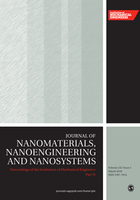
Proceedings of the Institution of Mechanical Engineers Part N-Journal of Nanomaterials Nanoengineering and Nanosystems
Innovating at the Nanoscale: Where Science Meets EngineeringProceedings of the Institution of Mechanical Engineers Part N - Journal of Nanomaterials Nanoengineering and Nanosystems is a premier journal published by SAGE Publications Ltd that focuses on advancing the field of nanotechnology through high-quality research and critical review articles. With an ISSN of 2397-7914 and an E-ISSN of 2397-7922, this journal serves as a vital platform for researchers and industry professionals exploring the interdisciplinary applications of nanomaterials and nanoengineering. The journal has achieved a significant standing in the academic community, reflected in its Q3 ranking across multiple categories including Condensed Matter Physics, Electrical and Electronic Engineering, and Materials Science for 2023, positioning it within the 75th percentile in relevant fields. Covering topics that range from fundamental research to practical applications, the journal aims to disseminate findings that push the boundaries of materials science and engineering. With open access options available, it ensures that groundbreaking research is accessible to a global audience. The proceedings are published from 2016 to 2024 and are vital for anyone involved in the rapidly evolving domain of nanoscience.
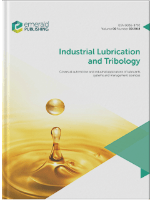
INDUSTRIAL LUBRICATION AND TRIBOLOGY
Advancing lubrication science for a sustainable future.INDUSTRIAL LUBRICATION AND TRIBOLOGY, published by EMERALD GROUP PUBLISHING LTD, is a distinguished journal dedicated to the fields of lubrication science and tribology, examining the fundamental aspects and innovative applications that enhance energy efficiency and mechanical performance in industrial settings since its inception in 1948. With an ISSN of 0036-8792, the journal is indexed in recognized databases, and its significant contributions have earned it a respectable Q3 category ranking in the disciplines of Energy, Mechanical Engineering, and Surfaces, Coatings, and Films. Researchers and professionals engaged in these fields will find valuable insights and cutting-edge research that drive innovation and improve the sustainability of industrial practices. While the journal does not currently offer open access options, it continues to be a pivotal platform for disseminating knowledge among scholars and practitioners. Its ongoing relevance in advancing tribological science highlights the critical role of lubrication in enhancing machine longevity and operational efficiency.
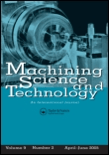
MACHINING SCIENCE AND TECHNOLOGY
Unleashing Cutting-Edge Research in Machining TechnologyMACHINING SCIENCE AND TECHNOLOGY, published by Taylor & Francis Inc, is a leading academic journal that focuses on the multifaceted disciplines of machining and manufacturing processes, materials science, and mechanical engineering. With an established presence in the field since 1997 and a projection of continued relevance until 2024, this journal plays a critical role in disseminating cutting-edge research and innovative practices within these sectors. The journal holds a significant standing with a Q2 ranking in Industrial and Manufacturing Engineering, Materials Science, and Mechanical Engineering, reflecting its influential contributions to these fields. According to Scopus rankings, it positions itself in the top percentiles, showcasing its commitment to high-quality peer-reviewed publications. Researchers and professionals will find valuable insights and trends that cater to the ever-evolving landscape of machining technology and materials science, enriching their academic and practical endeavors.

Tribology Online
Connecting global experts in the science of surfaces.Tribology Online, published by the Japan Society of Tribologists, is a dynamic open-access journal dedicated to the domain of tribology, encompassing research on surfaces, coatings, and films. Launched in 2013, this journal serves as a crucial platform for disseminating innovative findings in the field, highlighting its commitment to advancing knowledge and practice in tribological science. With an impact factor that places it in the Q3 quartile for the category of Surfaces, Coatings and Films, Tribology Online ranks 93rd out of 132 journals in its field, reflecting a growing engagement from the academic community. Open access since 2017, the journal promotes wide accessibility to research trends and technological advancements, making it an essential resource for researchers, professionals, and students pursuing cutting-edge developments in material sciences. Based in Tokyo, Japan, it aims to connect global experts and contribute to the evolution of tribological knowledge.
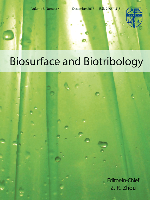
Biosurface and Biotribology
Advancing Knowledge at the Intersection of Biology and TribologyBiosurface and Biotribology, published by WILEY, is an innovative Open Access journal that has been dedicated to advancing the fields of biomaterials, biomedical engineering, and tribology since its inception. With a focus on the surface interactions and tribological behaviors of materials, this journal serves as an essential platform for researchers and professionals eager to explore the intersections of engineering, materials science, and biophysics. While it holds a current categorization in the Q4 quartile for biomaterials and biomedical engineering and a Q3 ranking in mechanical engineering, the journal's commitment to disseminating high-quality, peer-reviewed research contributes to its growing visibility and relevance in the academic landscape. With open access since 2018, it ensures that the latest research is freely available to all, fostering collaboration and innovation. Whether you are a graduate student, a seasoned researcher, or a professional in the field, Biosurface and Biotribology is your gateway to cutting-edge insights and developments that are shaping the future of biomaterials and surface engineering.

JOURNAL OF MATERIALS ENGINEERING AND PERFORMANCE
Unlocking the Potential of Advanced MaterialsJOURNAL OF MATERIALS ENGINEERING AND PERFORMANCE, published by Springer, serves as a vital resource for researchers and professionals in the fields of materials science, mechanical engineering, and mechanics of materials. With an ISSN of 1059-9495 and E-ISSN of 1544-1024, this journal boasts a commendable track record since its inception in 1992 and is set to continue providing valuable insights until 2024. Positioned in the Q2 quartile of its categories, the journal is ranked #246 in Mechanical Engineering and #168 in Mechanics of Materials according to Scopus, reflecting its commitment to high-quality research. While currently not adopting an open access model, it remains accessible to academic professionals and students eager to advance their knowledge in the rapidly evolving domain of materials engineering. The scope encompasses innovative research focused on material performance, engineering applications, and technological advancements, making it an indispensable tool for those at the forefront of the field.
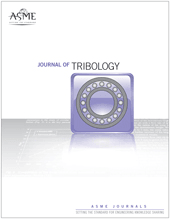
JOURNAL OF TRIBOLOGY-TRANSACTIONS OF THE ASME
Elevating Standards in Mechanical Systems ResearchJOURNAL OF TRIBOLOGY-TRANSACTIONS OF THE ASME, published by the esteemed American Society of Mechanical Engineers (ASME), is a prominent peer-reviewed journal dedicated to the intricate study of tribological phenomena and their impact on mechanical systems. With an ISSN of 0742-4787 and an E-ISSN of 1528-8897, this journal has been a vital resource since its inception in 1967, covering significant developments in mechanical engineering, mechanics of materials, surfaces, and interfaces. Ranked in the Q2 quartile across multiple categories for 2023, including Mechanical Engineering and Surfaces and Interfaces, it reflects a respectable impact within the research community, with Scopus rankings highlighting its stature in various related fields. While it does not offer open access, its contributions to the understanding of wear, lubrication, and surface engineering are invaluable for researchers, professionals, and students alike, fostering advancements in both academic and industrial applications. With a commitment to disseminating high-quality research, this journal continues to be an essential platform for those seeking to push the boundaries of tribology and its applications.
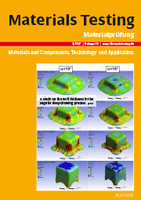
Materials Testing
Connecting Theory and Practice in Material ApplicationsMaterials Testing is a renowned journal published by Walter de Gruyter GmbH, serving the global scientific community in the fields of Materials Science, Mechanical Engineering, and Mechanics of Materials. With an ISSN of 0025-5300 and an E-ISSN of 2195-8572, this journal has been a significant contributor to the discourse on material performance, testing methodologies, and engineering innovations since its inception. The journal is recognized for its rigorous peer-review process and holds a commendable Q2 quartile ranking in multiple categories for 2023, showcasing its impact and relevance in the field. With open access options available, Materials Testing aims to disseminate valuable research findings and practical insights that drive advancements in technology and materials applications. By addressing the latest challenges and developments within the field, this publication serves as an essential resource for researchers, professionals, and students alike, fostering a deeper understanding of material properties and testing techniques.

Tribology International
Catalyzing New Ideas in the World of Tribology.Tribology International, published by ELSEVIER SCI LTD, stands as a premier journal in the fields of tribology, mechanical engineering, and material science. With an impressive impact factor and ranking in the Q1 category across multiple disciplines such as Mechanical Engineering and Surfaces, Coatings and Films, this journal serves as a critical resource for researchers, professionals, and students looking to advance their knowledge and application of tribological principles. Established in 1972, Tribology International explores a wide array of topics, including friction, wear, and lubrication, making it indispensable for those dedicated to innovation in engineering and materials sciences. With its rigorous peer-review process and high visibility within the academic community, Tribology International is pivotal in disseminating influential research, fostering new ideas, and shaping the future of tribological research.